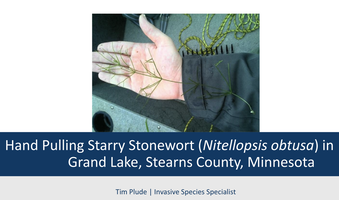
STARRY STONEWORT
What is Starry Stonewort
Starry stonewort is a non-native species of large algae in the Characeae family. It has whorls of 4-6 long branchlets. It is more robust than most members of its family, and can grow to over two meters tall. Anchored by colorless filaments (rhizoids) that contain up to several dozen 4-5mm, star- shaped bulbils, starry stonewort typically grows in marl sediments of alkaline lakes, up to 9 meters deep. Orange, male reproductive structures are located in the axils of the upper branchlets. Starry stonewort typically dies back to the sediments in the fall, but may persist during mild winters. Interestingly, starry stonewort is listed as an endangered species in the United Kingdom.
How to identify Starry Stonewort
Starry Stonewort is similar in appearance to native grass-like algae such as other stoneworts and musk-grass, which are commonly found in MN waters. Starry Stonewort can be distinguished from other grass-like algae by the presence of star-shaped bulbils.
• Starry Stonewort Management in Grand Lake 2018
(click to download presentation).
Starry Stonewort Fact Sheets
Chara looks like Starry Stonewort. Click Here for a fact sheet on how to compare the two.
If you suspect you have found Starry Stonewort or any other invasive species, note the exact location, don't disturb the area, take a photo or keep the specimen and contact:
Scott Palmer 320•249•1333, Jim Bartelme 734•730•7421 or Jim Meinz 320•249•3996. Early detection is key! Why is Starry Stonewort a problem?
Starry Stonewort can interfere with recreational and other uses of the lake by producing dense mats at the waters surface. Boats are not able to get through these dense mats. It may displace native aquatic plants and choke out fish spawning beds.
How does it spread?
Starry Stonewort is believed to be spread from one body of water to another by unintentional transfer of plant fragments and bulbils, the star-like structures produced by the plant. The fragments, or mud containing the fragments, can be transferred on trailered boats, personal watercraft, docks, boat lifts, anchors or any other water-related equipment that has not been properly cleaned.
What can people do to prevent its spread?
The most important action you can do to prevent the spread of Starry Stonewort is to Clean, Drain, Dispose, which is required by law in MN.
• Clean all vegetation, animals, mud & debris from your watercraft and any water-related equipment before moving it from one body of water to another.
• Drain all water from your watercraft and bait bucket(s), including lowering the lower unit once you're out of the water to allow the water to drain before installing the transom saver bar and keep the drain plugs out during transport.
• Dispose of any unwanted bait in the trash.
Right now there are no laws limiting access to Starry Stonewort infected waters, but keeping water related equipment out of the infected lakes right now while they are trying to find a treatment would be the safest.
What can be done to reduce Starry Stonewort?
There has not been much success in reducing or eliminating it. It appears that treatment with herbicides can suppress it. Some states use hand pulling to reduce biomass in small areas. Mechanical removal can also be effective, but not recommended in newly discovered lakes that have limited distribution in the lake. Mechanical harvesting might create fragments that would speed up the spread of the invasive plant within the lake.
What is Starry Stonewort
Starry stonewort is a non-native species of large algae in the Characeae family. It has whorls of 4-6 long branchlets. It is more robust than most members of its family, and can grow to over two meters tall. Anchored by colorless filaments (rhizoids) that contain up to several dozen 4-5mm, star- shaped bulbils, starry stonewort typically grows in marl sediments of alkaline lakes, up to 9 meters deep. Orange, male reproductive structures are located in the axils of the upper branchlets. Starry stonewort typically dies back to the sediments in the fall, but may persist during mild winters. Interestingly, starry stonewort is listed as an endangered species in the United Kingdom.
How to identify Starry Stonewort
Starry Stonewort is similar in appearance to native grass-like algae such as other stoneworts and musk-grass, which are commonly found in MN waters. Starry Stonewort can be distinguished from other grass-like algae by the presence of star-shaped bulbils.
• Starry Stonewort Management in Grand Lake 2018
(click to download presentation).
Starry Stonewort Fact Sheets
- Click to download Starry Stonewort Fact Sheet
- Click to download Quick Guide for Starry Stonewort
- Click to view video to identify Starry Stonewort.
- More information on identification found here: MN DNR Starry Stonewort.
Chara looks like Starry Stonewort. Click Here for a fact sheet on how to compare the two.
If you suspect you have found Starry Stonewort or any other invasive species, note the exact location, don't disturb the area, take a photo or keep the specimen and contact:
Scott Palmer 320•249•1333, Jim Bartelme 734•730•7421 or Jim Meinz 320•249•3996. Early detection is key! Why is Starry Stonewort a problem?
Starry Stonewort can interfere with recreational and other uses of the lake by producing dense mats at the waters surface. Boats are not able to get through these dense mats. It may displace native aquatic plants and choke out fish spawning beds.
How does it spread?
Starry Stonewort is believed to be spread from one body of water to another by unintentional transfer of plant fragments and bulbils, the star-like structures produced by the plant. The fragments, or mud containing the fragments, can be transferred on trailered boats, personal watercraft, docks, boat lifts, anchors or any other water-related equipment that has not been properly cleaned.
What can people do to prevent its spread?
The most important action you can do to prevent the spread of Starry Stonewort is to Clean, Drain, Dispose, which is required by law in MN.
• Clean all vegetation, animals, mud & debris from your watercraft and any water-related equipment before moving it from one body of water to another.
• Drain all water from your watercraft and bait bucket(s), including lowering the lower unit once you're out of the water to allow the water to drain before installing the transom saver bar and keep the drain plugs out during transport.
• Dispose of any unwanted bait in the trash.
Right now there are no laws limiting access to Starry Stonewort infected waters, but keeping water related equipment out of the infected lakes right now while they are trying to find a treatment would be the safest.
What can be done to reduce Starry Stonewort?
There has not been much success in reducing or eliminating it. It appears that treatment with herbicides can suppress it. Some states use hand pulling to reduce biomass in small areas. Mechanical removal can also be effective, but not recommended in newly discovered lakes that have limited distribution in the lake. Mechanical harvesting might create fragments that would speed up the spread of the invasive plant within the lake.
